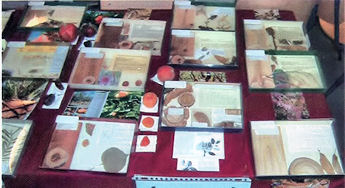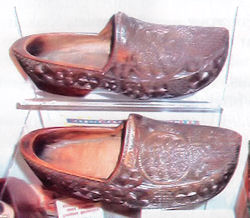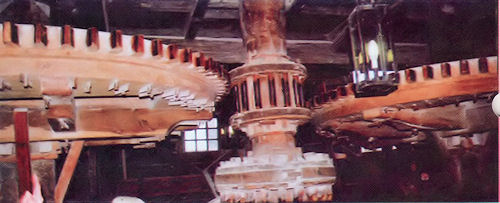
Netherlands Meeting, June 10-25 2009
| |||||||||
IWCS members from nine countries: Spain, France, UK, Italy, Germany, Australia, Canada, US, and the Netherlands, participated in what was one of the most memorable annual meetings held outside the US and is the first meeting held in a non-English speaking country. This meeting truly represented the aims and spirit of IWCS core values and was a credit to the small team of organizers. As a centrepiece of attention, there is no escaping the importance of windmills, water and wood in the history of The Netherlands. These three elements were the major focus of this well run meeting. Windmills For starters, Dutch windmills are made almost entirely of wood, structurally and mechanically. The only exceptions being the thatched reed roofing, the grinding stones, and the metal saw blades. Invented around 1600, long before the industrial revolution, windmills were the first large mechanical devices invented to perform the work of industry. They were built to pump water, grind grain, mill wood. They were 'green' machines deriving their energy from what nature provided and leaving no pollution—invented long before steam, internal combustion, or electric engines. IWCS members were privileged to enter these creaking almost ethereal powerhouses and experience the conversion of wind energy for grinding, sawing, and milling operations. There would be but a handful of people in the world today who would start their day's work by setting the sails of a windmill in order to grind and press flax seed to produce linseed oil for paint and inks and linseed cake for cattle feed. This man is
By the way Willems sample collection is getting up there with the best at 4,500 species and 6,000 specimens. A log being sawn using the power One of the first stories I can recall from my early school days was of the Dutch boy who saved Holland by putting his finger in the dyke and so keeping out the sea. At the meeting this story was trashed as being false, however, it sits indelibly in the minds of many throughout the world. The majority of land in the Netherlands is the result of engineering magic, being located on the delta of northern Europe's river systems, most of the land is below sea level, and it's disconcerting to travel through a landscape where all the rivers are metres above ground level and you never seem to be more than 100 m from surface water of some sort, whether that be a dam, canal, or drainage channel. The country relies on it's ability to pump water from the land into the sea and so create new "polders" as more and more land is reclaimed from the sea. Most rivers are trafficable by ships and locks are frequent. We were privileged to visit one river however, where the entrance is guarded by movable gates the radius of which are bigger than the height of the Eiffel Tower, contain twice as much steel, and are capable of shutting out the sea in times of North Sea storms or during huge swells, or a rise in sea levels. Absolutely incredible technology. Wood and craftsNot only were we shown the Dutch windmills, but we were also shown the timber outlets and large wood warehouses.  Manuel Soler of Spain talking to Dieter Becker of Germany in front of Dieter's intricate marquetry. As a wood meeting I believe this was the most sample oriented meeting I think I have ever attended. In combining with HCTO and NEHOSOC there was huge interest in swapping, trading and in the auction of samples. From memory this is the first time that individual samples auctioned off at a higher price than most of the craft items—amazing, but very. |
As an indicator of the number of specimens just in the suction—there wer5e over 500 "individual items" auctioned for the benefit of IWCS. However, consider that many of these items were lots of ten individual specimens and the sheer total number of specimens made available becomes rather large. 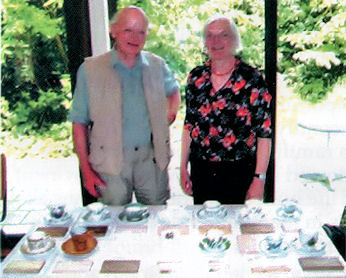 Piet Versteegh and Marie-Louise Friedrichs' tea cup art and matching wood collection Even though this meeting was relatively small in terms of total registration, it took on the look and feel of a much larger meeting when one viewed the large display room organized and set up by a relatively new IWCS member, Frans Steenland. This display of wood crafts and educational material covered a full range of intricate craft world brought by members and nonmembers alike. The large display of intricate marquetry pieces done by Dieter Becker (see also World of Wood, May/June 2009) caused one to believe they were in a museum of precious art works. Then there were the absolutely spectacular and sharp 150x end grain colour photographs of new member Jean-Cllaude Cerre of France, a retired dentist and master photographer. Jean-Claude gave a most illuminating presentation of his end grain preparation and photographic techniques—hopefully we can look forward to seeing more from him on this subject in coving issues of World of Wood. For absolute charm and uniqueness the tea cup art and wood collection display of Marie-Louise Friedrichs and Piet Versteegh, was hard to forget. Each tea cup in the display feature a tree or leaf or flowers of one, and a matching wood specimen from Piet's collection was shown with each cup so presented.
Frans Steenland's educational display of wood and related botanical material from the tree of each was something to comprehend. The picture shows only a small portion of Frans's remarkable educational display. He takes it to school children and other groups around the country—and it is called by him "Behind the Bark". And it is designed to give people a look and at the remarkable variety and usefulness of products provided by trees—and how to identify them—along with a specimen of the wood and a cross-section of a limb or small trunk of the tree or shrub in question. This is really another facet of what IWCS is all about—spreading information on wood and its sources and allied products. The foregoing are only some of the highlights of the remarkable display room at the Dutch IWCS meeting. There were many other interesting crafts and wood specimen displays on view. In addition, the author himself, Richard Crow, long time IWCS member, was there to release and introduce his new book, A Man of the Woods, experiences in collecting over 7,000 woods of the world. We hope to bring you a review of this delightful adventure story in a future issue of World of Wood.
Wooden shoes
From the pre-meeting tours to the meeting itself and to the post-meeting tours, attendants at this meeting were given a thorough immersion into the Dutch culture and landscape. The opportunity to meet with members of two other wood collecting societies, those in Belgium and the Dutch NEHOSOC, was a memorable first. Our IWCS hats are off to the organizers of this meeting, Nelis, Willem, and Frans and their willing helpers for making our attendance there most educational, pleasurable and memorable. Bravo, well done! |
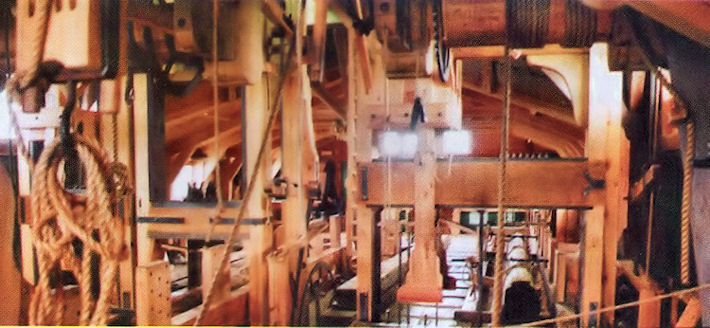 The wind can drive two multi-blade sawing heads—shown here. The only sounds being the rip of the saw blades and the creaking of the drive mechanism.
| |

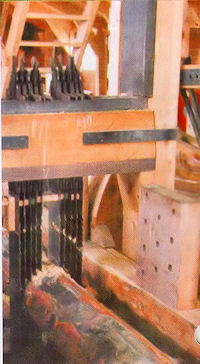 The huge 8 meter drive shafts are of deal or scots pine (Pinus sylvestris). You would think that oak would be used, however it shatters and splits whereas deal has some give in it.
The huge 8 meter drive shafts are of deal or scots pine (Pinus sylvestris). You would think that oak would be used, however it shatters and splits whereas deal has some give in it.